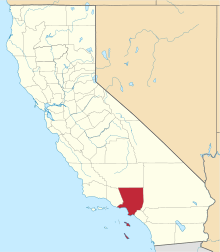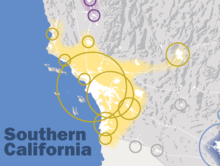Santa Monica, California
Santa Monica (Spanish for 'Saint Monica') is a beachfront city in western Los Angeles County, California, United States. Situated on Santa Monica Bay, it is bordered on three sides by different neighborhoods of the city of Los Angeles: Pacific Palisades to the north, Brentwood on the northeast, West Los Angeles on the east, Mar Vista on the southeast, and Venice on the south. The 2010 U.S. Census population was 89,736. Due to a favorable climate and close proximity to Los Angeles, Santa Monica became a famed resort town by the early 20th century attracting many celebrities, like Marion Davies, to build magnificent beach front homes on Roosevelt Highway (PCH). The city has experienced a boom since the late 1980s through the revitalization of its downtown core, significant job growth and increased tourism. Popular tourists sites include Pacific Park on the Santa Monica Pier[12] and Palisades Park atop a bluff over the Pacific Ocean.
Santa Monica, California | |
|---|---|
City | |
| City of Santa Monica | |
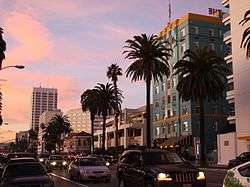 Santa Monica's Ocean Avenue at sunset | |
 Seal | |
| Nickname(s): SaMo[1] | |
| Motto(s): | |
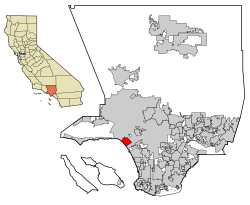 Location within Los Angeles County | |
 Santa Monica Location within the Los Angeles Metropolitan Area  Santa Monica Location within California  Santa Monica Location within the United States | |
| Coordinates: 34°01′19″N 118°28′53″W | |
| Country | |
| State | |
| County | |
| Spanish encampment | August 3, 1769 |
| Incorporated | November 30, 1886[3] |
| Named for | Saint Monica |
| Government | |
| • Type | Council–manager[4] |
| • Mayor | Kevin McKeown (D)[5] |
| Area | |
| • Total | 16.00 sq mi (41.43 km2) |
| • Land | 8.41 sq mi (21.80 km2) |
| • Water | 7.58 sq mi (19.64 km2) |
| Elevation | 105 ft (32 m) |
| Population | |
| • Total | 89,736 |
| • Estimate (2019)[9] | 90,401 |
| • Rank | 89th in California |
| • Density | 10,742.84/sq mi (4,147.77/km2) |
| Time zone | UTC−8 (Pacific) |
| • Summer (DST) | UTC−7 (PDT) |
| ZIP codes | 90401–90411 |
| Area codes | 310/424 |
| FIPS code | 06-70000[10] |
| GNIS feature IDs | 1652792, 2411825[11] |
| Website | www |
History
Santa Monica was inhabited by the Tongva people. Santa Monica was called Kecheek in the Tongva language.[13] The first non-indigenous group to set foot in the area was the party of explorer Gaspar de Portolà, who camped near the present-day intersection of Barrington and Ohio Avenues on August 3, 1769. Named after the Christian saint Monica, there are two different accounts of how the city's name came to be. One says it was named in honor of the feast day of Saint Monica (mother of Saint Augustine), but her feast day is May 4. Another version says it was named by Juan Crespí on account of a pair of springs, the Kuruvungna Springs (Serra Springs), that were reminiscent of the tears Saint Monica shed over her son's early impiety.[14]

Following the Mexican–American War, Mexico signed the Treaty of Guadalupe Hidalgo, which gave Mexicans and Californios living in state certain unalienable rights. US government sovereignty in California began on February 2, 1848.
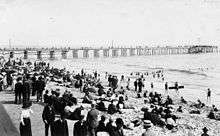
In the 1870s, the Los Angeles and Independence Railroad connected Santa Monica with Los Angeles, and a wharf out into the bay. The first town hall was an 1873 brick building, later a beer hall, and now part of the Santa Monica Hostel. It is Santa Monica's oldest extant structure. By 1885, the town's first hotel was the Santa Monica Hotel.[15]
Amusement piers became popular in the first decades of the 20th century and the extensive Pacific Electric Railroad brought people to the city's beaches from across the Greater Los Angeles Area.
.jpg)
Around the start of the 20th century, a growing population of Asian Americans lived in and around Santa Monica and Venice. A Japanese fishing village was near the Long Wharf while small numbers of Chinese lived or worked in Santa Monica and Venice. The two ethnic minorities were often viewed differently by White Americans who were often well-disposed towards the Japanese but condescending towards the Chinese.[16] The Japanese village fishermen were an integral economic part of the Santa Monica Bay community.[17]
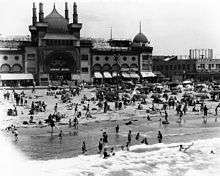
Donald Wills Douglas, Sr. built a plant in 1922 at Clover Field (Santa Monica Airport) for the Douglas Aircraft Company.[18] In 1924, four Douglas-built planes took off from Clover Field to attempt the first aerial circumnavigation of the world. Two planes returned after covering 27,553 miles (44,342 km) in 175 days, and were greeted on their return September 23, 1924, by a crowd of 200,000. The Douglas Company (later McDonnell Douglas) kept facilities in the city until the 1960s.
The Great Depression hit Santa Monica deeply. One report gives citywide employment in 1933 of just 1,000. Hotels and office building owners went bankrupt. In the 1930s, corruption infected Santa Monica (along with neighboring Los Angeles). The federal Works Project Administration helped build several buildings, most notably City Hall. The main Post Office and Barnum Hall (Santa Monica High School auditorium) were also among other WPA projects.
Douglas's business grew with the onset of World War II, employing as many as 44,000 people in 1943. To defend against air attack, set designers from the Warner Brothers Studios prepared elaborate camouflage that disguised the factory and airfield.[19][20] The RAND Corporation began as a project of the Douglas Company in 1945, and spun off into an independent think tank on May 14, 1948. RAND acquired a 15-acre (61,000 m2) campus across the street from the Civic Center and is still there today.
The completion of the Santa Monica Civic Auditorium in 1958 eliminated Belmar, the first African American community in the city,[21] and the Santa Monica Freeway in 1966 decimated the Pico neighborhood that had been a leading African American enclave on the Westside.
Beach volleyball is believed to have been developed by Duke Kahanamoku in Santa Monica during the 1920s.[22]
Santa Monica has two hospitals: Saint John's Health Center and Santa Monica-UCLA Medical Center. Its cemetery is Woodlawn Memorial.
Santa Monica has several local newspapers including Santa Monica Daily Press, Santa Monica Mirror, Santa Monica Star, and Santa Monica Observer.
Attractions and cultural resources
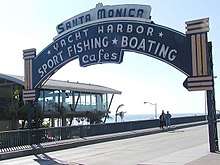
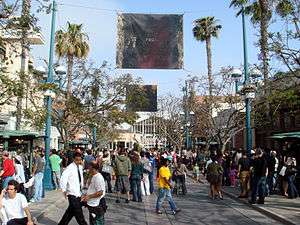
Music and Arts Venues
The Santa Monica Looff Hippodrome (carousel) is a National Historic Landmark. It sits on the Santa Monica Pier, which was built in 1909. The La Monica Ballroom on the pier was once the largest ballroom in the US and the source for many New Year's Eve national network broadcasts.
The Santa Monica Civic Auditorium was an important music venue for several decades and hosted the Academy Awards in the 1960s. McCabe's Guitar Shop is a leading acoustic performance space as well as retail outlet. The Santa Monica Playhouse is a popular theater in the city.
Bergamot Station is a city-owned art gallery compound that includes the Santa Monica Museum of Art. The city is also home to the California Heritage Museum and the Angels Attic dollhouse and toy museum.
The New West Symphony is the resident orchestra of Barnum Hall. They are also resident orchestra of the Oxnard Performing Arts Center and the Thousand Oaks Civic Arts Plaza.
Shopping Districts
Santa Monica has three main shopping districts: Montana Avenue on the north side, the Downtown District in the city's core, and Main Street on the south end. Each has its own unique feel and personality. Montana Avenue is a stretch of luxury boutique stores, restaurants, and small offices that generally features more upscale shopping. The Main Street district offers an eclectic mix of clothing, restaurants, and other specialty retail.
Third Street Promenade
The Downtown District is the home of the Third Street Promenade, a major outdoor pedestrian-only shopping district that stretches for three blocks between Wilshire Blvd. and Broadway (not the same Broadway in downtown and south Los Angeles). Third Street is closed to vehicles for those three blocks to allow people to stroll, congregate, shop and enjoy street performers.
Santa Monica Place
Santa Monica Place, featuring Bloomingdale's and Nordstrom in a three-level outdoor environment, is at the Promenade's southern end. After a period of redevelopment, the mall reopened in the fall of 2010 as a modern shopping, entertainment and dining complex with more outdoor space.
Santa Monica hosts the annual Santa Monica Film Festival.
The city's oldest movie theater is the Majestic. Opened in 1912 and also known as the Mayfair Theatre, the theater, it has been closed since the 1994 Northridge earthquake. The Aero Theater (now operated by the American Cinematheque) and Criterion Theater were built in the 1930s and still show movies. The Santa Monica Promenade alone supports more than a dozen movie screens.
Parks
Palisades Park stretches out along the crumbling bluffs overlooking the Pacific and is a favorite walking area to view the ocean. It includes public art, a totem pole, camera obscura, benches, picnic areas, pétanque courts, and restrooms.
Tongva Park occupies 6 acres between Ocean Avenue and Main Street, just south of Colorado Avenue. The park includes an overlook, amphitheater, playground, garden, fountains, picnic areas, and restrooms.
The Santa Monica Stairs, a long, steep staircase that leads from north of San Vicente down into Santa Monica Canyon, is a popular spot for outdoor workouts. Some area residents have complained that the stairs have become too popular, and attract too many exercisers to the wealthy neighborhood of multimillion-dollar properties.[23]
Geography
The city of Santa Monica rests on a mostly flat slope that angles down towards Ocean Avenue and towards the south. High bluffs separate the north side of the city from the beaches. Santa Monica borders the L.A. neighborhoods of Pacific Palisades to the north and Venice to the south. To the west, Santa Monica has the 3-mile coastline fronting the Santa Monica Bay, and to the east of the city borders are the Los Angeles communities of West Los Angeles and Brentwood.
Climate
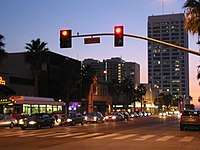
Santa Monica has a coastal Mediterranean climate (Köppen Csb). Santa Monica enjoys an average of 310 days of sunshine a year.[24] It is in USDA plant hardiness zone 10a.[25] Because of its location, nestled on the vast and open Santa Monica Bay, morning fog is a common phenomenon in May, June, July and early August (caused by ocean temperature variations and currents). Like other inhabitants of the greater Los Angeles area, residents have a particular terminology for this phenomenon: the "May Gray", the "June Gloom" and even “Fogust”. Overcast skies are common during June mornings, but usually the strong sun burns the fog off by noon. In the late winter/early summer, daily fog is a phenomenon too. It happens suddenly and it may last some hours or past sunset time.[26] Nonetheless, it will sometimes stay cloudy and cool all day during June, even as other parts of the Los Angeles area enjoy sunny skies and warmer temperatures. At times, the sun can be shining east of 20th Street, while the beach area is overcast. As a general rule, the beach temperature is from 5 to 10 degrees Fahrenheit (3 to 6 degrees Celsius) cooler than it is inland during summer days, and 5–10 degrees warmer during winter nights.
It is also in September highest temperatures tend to be reached. It is winter, however, when the hot, dry winds of the Santa Anas are most common. In contrast, temperatures exceeding 10 degrees below average are rare.
The rainy season is from late October through late March. Winter storms usually approach from the northwest and pass quickly through the Southland. There is very little rain during the rest of the year. Yearly rainfall totals are unpredictable as rainy years are occasionally followed by droughts. There has never been any snow or frost, but there has been hail.
Santa Monica usually enjoys cool breezes blowing in from the ocean, which tend to keep the air fresh and clean. Therefore, smog is less of a problem for Santa Monica than elsewhere around Los Angeles. However, in the autumn months of September through November, the Santa Ana winds will sometimes blow from the east, bringing smoggy and hot inland air to the beaches.
| Climate data for Santa Monica Pier, California | |||||||||||||
|---|---|---|---|---|---|---|---|---|---|---|---|---|---|
| Month | Jan | Feb | Mar | Apr | May | Jun | Jul | Aug | Sep | Oct | Nov | Dec | Year |
| Record high °F (°C) | 85 (29) |
89 (32) |
90 (32) |
91 (33) |
93 (34) |
92 (33) |
99 (37) |
95 (35) |
94 (34) |
99 (37) |
100 (38) |
89 (32) |
100 (38) |
| Mean maximum °F (°C) | 77.0 (25.0) |
76.8 (24.9) |
73.3 (22.9) |
77.1 (25.1) |
72.0 (22.2) |
73.2 (22.9) |
76.2 (24.6) |
76.8 (24.9) |
79.8 (26.6) |
83.9 (28.8) |
79.9 (26.6) |
75.4 (24.1) |
87.8 (31.0) |
| Average high °F (°C) | 63.7 (17.6) |
63.2 (17.3) |
62.5 (16.9) |
64.0 (17.8) |
64.6 (18.1) |
67.0 (19.4) |
69.8 (21.0) |
70.3 (21.3) |
70.7 (21.5) |
69.4 (20.8) |
67.1 (19.5) |
63.7 (17.6) |
66.3 (19.1) |
| Average low °F (°C) | 50.9 (10.5) |
51.4 (10.8) |
52.5 (11.4) |
54.4 (12.4) |
57.0 (13.9) |
60.0 (15.6) |
62.6 (17.0) |
63.2 (17.3) |
62.8 (17.1) |
59.7 (15.4) |
55.0 (12.8) |
50.8 (10.4) |
56.6 (13.7) |
| Mean minimum °F (°C) | 43.6 (6.4) |
44.8 (7.1) |
46.0 (7.8) |
48.2 (9.0) |
51.9 (11.1) |
55.8 (13.2) |
58.9 (14.9) |
59.3 (15.2) |
57.9 (14.4) |
53.9 (12.2) |
47.7 (8.7) |
44.0 (6.7) |
41.6 (5.3) |
| Record low °F (°C) | 34 (1) |
35 (2) |
33 (1) |
39 (4) |
43 (6) |
45 (7) |
49 (9) |
51 (11) |
44 (7) |
42 (6) |
37 (3) |
34 (1) |
33 (1) |
| Average precipitation inches (mm) | 2.84 (72) |
3.44 (87) |
1.96 (50) |
0.66 (17) |
0.21 (5.3) |
0.04 (1.0) |
0.01 (0.25) |
0.04 (1.0) |
0.13 (3.3) |
0.50 (13) |
1.08 (27) |
1.88 (48) |
12.79 (325) |
| Average rainy days | 7.0 | 7.9 | 5.1 | 2.4 | 1.0 | 0.4 | 0.1 | 0.5 | 1.0 | 0.8 | 2.5 | 4.0 | 32.7 |
| Source: NOAA[27] | |||||||||||||
Environment
The city first proposed its Sustainable City Plan in 1992 and in 1994, was one of the first cities in the nation to formally adopt a comprehensive sustainability plan, setting waste reduction and water conservation policies for both public and private sector through its Office of Sustainability and the Environment.[28] Eighty-two percent of the city's public works vehicles run on alternative fuels, including most of the municipal bus system, making it among the largest such fleets in the country. Santa Monica fleet vehicles and buses source their natural gas from Redeem, a Southern California-based supplier of renewable and sustainable natural gas obtained from non-fracked methane biogas generated from organic landfill waste.[29]
Santa Monica adopted a Community Energy Independence Initiative, with a goal of achieving complete energy independence by 2020 (vs. California's already ambitious 33% renewables goal).[30][31] The city exceeded that aspiration when, in February 2019, it switched over to electricity from the Clean Power Alliance,[32] with a citywide default of 100% renewably sourced energy.[33] That same year, the Santa Monica City Council adopted a Climate Action and Adaptation Plan aimed at achieving an 80% cut in carbon emissions by 2030, and reaching community-wide carbon neutrality by 2050 or sooner.[34]
An urban runoff facility (SMURFF), the first of its kind in the US, catches and treats 3.5 million US gallons (13,000 m3) of water each week that would otherwise flow into the bay via storm-drains and sells it back to end-users within the city for reuse as gray-water,[35] while bioswales throughout the city allow rainwater to percolate into and replenish the groundwater. The groundwater supply plays an important role in the city's Sustainable Water Master Plan, whereby Santa Monica has set a goal of attaining 100% water independence by 2020.[36] The city has numerous programs designed to promote water conservation among residents, including a rebate for those who convert lawns to drought-tolerant gardens that require less water.[35]
Santa Monica has also instituted a green building-code whereby merely constructing to code automatically renders a building equivalent to the US Green Building Council's LEED Silver standards.[37] The city's Main Library is one of many LEED certified or LEED equivalent buildings in the city. It is built over a 200,000 gallon cistern that collects filtered stormwater from the roof. The water is used for landscape irrigation.
Since 2009, Santa Monica has been developing the Zero Waste Strategic Operations Plan by which the city will set a goal of diverting at least 95% of all waste away from landfills, and toward recycling and composting, by 2030. The plan includes a food waste composting program, which diverts 3 million pounds of restaurant food waste away from landfills annually. Currently, 77% of all solid waste produced citywide is diverted from landfills.[38]
The city is also in the process of implementing a 5-year and 20 year Bike Action Plan with a goal of attaining 14 to 35% bicycle transportation mode share by 2030 through the installation of enhanced bicycle infrastructure throughout the city.[39] Other environmentally focused initiatives include curbside recycling, curbside composting bins (in addition to trash, yard-waste, and recycle bins), farmers' markets, community gardens, garden-share, an urban forest initiative, a hazardous materials home-collection service, and a green business certification.[40][41]
Demographics
| Historical population | |||
|---|---|---|---|
| Census | Pop. | %± | |
| 1880 | 417 | — | |
| 1890 | 1,580 | 278.9% | |
| 1900 | 3,057 | 93.5% | |
| 1910 | 7,847 | 156.7% | |
| 1920 | 15,252 | 94.4% | |
| 1930 | 37,146 | 143.5% | |
| 1940 | 53,500 | 44.0% | |
| 1950 | 71,595 | 33.8% | |
| 1960 | 83,249 | 16.3% | |
| 1970 | 88,289 | 6.1% | |
| 1980 | 88,314 | 0.0% | |
| 1990 | 86,905 | −1.6% | |
| 2000 | 84,084 | −3.2% | |
| 2010 | 89,736 | 6.7% | |
| Est. 2019 | 90,401 | [9] | 0.7% |
| U.S. Decennial Census[42] | |||
Santa Monica's population has grown from 417 in 1880 to 89,736 in 2010.[43]
2010
The 2010 United States Census[44] reported Santa Monica had a population of 89,736. The population density was 10,662.6 people per square mile (4,116.9/km2). The racial makeup of Santa Monica was 69,663 (77.6%) White (70.1% Non-Hispanic White),[45] 3,526 (3.9%) African American, 338 (0.4%) Native American, 8,053 (9.0%) Asian, 124 (0.1%) Pacific Islander, 4,047 (4.5%) from other races, and 3,985 (4.4%) from two or more races. Hispanic or Latino of any race were 11,716 persons (13.1%), with Mexican Americans, Spanish Americans, and Argentine Americans making up 64.2%, 6.4%, and 4.7% of the Hispanic population respectively.[46]
The Census reported 87,610 people (97.6% of the population) lived in households, 1,299 (1.4%) lived in non-institutionalized group quarters, and 827 (0.9%) were institutionalized.
There were 46,917 households, out of which 7,835 (16.7%) had children under the age of 18 living in them, 13,092 (27.9%) were opposite-sex married couples living together, 3,510 (7.5%) had a female householder with no husband present, 1,327 (2.8%) had a male householder with no wife present. There were 2,867 (6.1%) unmarried opposite-sex partnerships, and 416 (0.9%) same-sex married couples or partnerships. 22,716 households (48.4%) were made up of individuals, and 5,551 (11.8%) had someone living alone who was 65 years of age or older. The average household size was 1.87. There were 17,929 families (38.2% of all households); the average family size was 2.79.
The population was spread out, with 12,580 people (14.0%) under the age of 18, 6,442 people (7.2%) aged 18 to 24, 32,552 people (36.3%) aged 25 to 44, 24,746 people (27.6%) aged 45 to 64, and 13,416 people (15.0%) who were 65 years of age or older. The median age was 40.4 years. For every 100 females, there were 93.2 males. For every 100 females age 18 and over, there were 91.2 males.
There were 50,912 housing units at an average density of 6,049.5 per square mile (2,335.7/km2), of which 13,315 (28.4%) were owner-occupied, and 33,602 (71.6%) were occupied by renters. The homeowner vacancy rate was 1.1%; the rental vacancy rate was 5.1%. 30,067 people (33.5% of the population) lived in owner-occupied housing units and 57,543 people (64.1%) lived in rental housing units.
According to the 2010 United States Census, Santa Monica had a median household income of $73,649, with 11.2% of the population living below the federal poverty line.[45]
2000
As of the census[10] of 2000, there were 84,084 people, 44,497 households, and 16,775 families in the city. The population density was 10,178.7 inhabitants per square mile (3,930.4/km2). There were 47,863 housing units at an average density of 5,794.0 per square mile (2,237.3/km2). The racial makeup of the city was 78.29% White, 7.25% Asian, 3.78% African American, 0.47% Native American, 0.10% Pacific Islander, 5.97% from other races, and 4.13% from two or more races. 13.44% of the population were Hispanic or Latino of any race. There were 44,497 households, out of which 15.8% had children under the age of 18, 27.5% were married couples living together, 7.5% had a female householder with no husband present, and 62.3% were non-families. 51.2% of all households were made up of individuals, and 10.6% had someone living alone who was 65 years of age or older. The average household size was 1.83 and the average family size was 2.80.
The city of Santa Monica is consistently among the most educated cities in the United States, with 23.8 percent of all residents holding graduate degrees.[47]
The population was diverse in age, with 14.6% under 18, 6.1% from 18 to 24, 40.1% from 25 to 44, 24.8% from 45 to 64, and 14.4% 65 years or older. The median age was 39 years. For every 100 females, there were 93.0 males. For every 100 females age 18 and over, there were 91.3 males.
According to a 2009 estimate, the median income for a household in the city was $71,095, and the median income for a family was $109,410.[48] Males had a median income of $55,689 versus $42,948 for females. The per capita income for the city was $42,874. 10.4% of the population and 5.4% of families were below the poverty line. Out of the total population, 9.9% of those under the age of 18 and 10.2% of those 65 and older were living below the poverty line.
Crime
In 2006, crime in Santa Monica affected 4.41% of the population, slightly lower than the national average crime rate that year of 4.48%.[49] The majority of this was property crime, which affected 3.74% of Santa Monica's population in 2006; this was higher than the rates for Los Angeles County (2.76%) and California (3.17%),[50] but lower than the national average (3.91%). These per-capita crime rates are computed based on Santa Monica's full-time population of about 85,000. However, the Santa Monica Police Department has suggested the actual per-capita crime rate is much lower, as tourists, workers, and beachgoers can increase the city's daytime population to between 250,000 and 450,000 people.[51]
Violent crimes affected 0.67% of the population in Santa Monica in 2006, in line with Los Angeles County (0.65%), but higher than the averages for California (0.53%) and the nation (0.55%).[49][50]
Hate crime has typically been minimal in Santa Monica, with only one reported incident in 2007. However, the city experienced a spike of anti-Islamic hate crime in 2001, following the attacks of September 11. Hate crime levels returned to their minimal 2000 levels by 2002.[52]
In 2006, Santa Monica voters passed "Measure Y" with a 65% majority,[53] which moved the issuance of citations for marijuana smoking to the bottom of the police priority list. A 2009 study by the Santa Monica Daily Press showed since the law took effect in 2007, the Santa Monica Police had "not issued any citations for offenses involving the adult, personal use of marijuana inside private residences."[54]
Gang activity
The Pico neighborhood of Santa Monica (south of the Santa Monica Freeway) experiences some gang activity. The city estimates there are about 50 gang members based in Santa Monica, although some community organizers dispute this claim.[55] Gang activity has been prevalent for decades in the Pico neighborhood.
In October 1998, alleged Culver City 13 gang member Omar Sevilla, 21, of Culver City was killed.[56] A couple of hours after the shooting of Sevilla, German tourist Horst Fietze was killed.[57] Several days later Juan Martin Campos, age 23, a Santa Monica city employee, was shot and killed. Police believe this was a retaliatory killing in response to the death of Omar Sevilla.[58] Less than twenty-four hours later, Javier Cruz was wounded in a drive-by shooting outside his home on 17th and Michigan.[59][60]
In 1999, there was a double homicide in the Westside Clothing store on Lincoln Boulevard. During the incident, Culver City gang members David "Puppet" Robles and Jesse "Psycho" Garcia entered the store masked and began opening fire, killing Anthony and Michael Juarez. They then ran outside to a getaway vehicle driven by a third Culver City gang member, who is now also in custody.[61] The clothing store was believed to be a local hang out for Santa Monica gang members. The dead included two men from Northern California who had merely been visiting the store's owner, their cousin, to see if they could open a similar store in their area. Police say the incident was in retaliation for a shooting committed by the Santa Monica 13 gang days before the Juarez brothers were gunned down.[62]
Aside from the rivalry with the Culver City gang, gang members also feud with the Venice and West Los Angeles gangs. The main rivals in these regions include Venice 13, Graveyard Gangster Crips, Hell's Bandidos and Venice Shoreline Crips gangs in the Oakwood area of Venice, California.
Education
Elementary and secondary schools
The Santa Monica-Malibu Unified School District provides public education at the elementary and secondary levels. In addition to the traditional model of early education school houses, SMASH (Santa Monica Alternative School House) is "a K-8 public school of choice with team teachers and multi-aged classrooms".[63]
Elementary schools
The district maintains eight public elementary schools in Santa Monica:[64]
- Edison Language Academy
- Franklin Elementary School
- Grant Elementary School
- John Muir Elementary School
- McKinley Elementary School
- Santa Monica Alternative School House [SMASH]
- Roosevelt Elementary School
- Will Rogers Learning Community
Middle schools
The district maintains three public middle schools in Santa Monica: John Adams Middle School, Lincoln Middle School and SMASH.[64]
High schools
The district maintains three high schools in Santa Monica: Olympic High School, Malibu High School and Santa Monica High School.[64]
Private schools
Private schools in the city include:
- Carlthorp School
- Santa Monica Montessori School
- Crossroads School
- Saint Monica Catholic Elementary School
- Concord High School
- Pacifica Christian High School
- Lighthouse Christian Academy[65]
- St. Anne Catholic School[66]
- Saint Monica Catholic High School
- New Roads School
- PS1 Pluralistic School
Miscellaneous education
Asahi Gakuen, a weekend Japanese supplementary school system, operates its Santa Monica campus (サンタモニカ校・高等部 Santamonika-kō kōtōbu) at Webster Middle in the Sawtelle neighborhood of Los Angeles. All high school classes in the Asahi Gakuen system are held at the Santa Monica campus.[67][68] As of 1986, students take buses from as far away as Orange County to go to the high school classes of the Santa Monica campus.[69]
Post-secondary
Santa Monica College is a community college founded in 1929. Many SMC graduates transfer to the University of California system. It occupies 35 acres (14 hectares) and enrolls 30,000 students annually. The Frederick S. Pardee RAND Graduate School, associated with the RAND Corporation, is the U.S.'s largest producer of public policy PhDs. The Art Institute of California – Los Angeles is also in Santa Monica near the Santa Monica Airport. Universities and colleges within a 22-mile (35 km) radius from Santa Monica include Santa Monica College, Antioch University Los Angeles, Loyola Marymount University, Mount St. Mary's University, Pepperdine University, California State University, Northridge, California State University, Los Angeles, UCLA, USC, West Los Angeles College, California Institute of Technology (Caltech), Occidental College (Oxy), Los Angeles City College, Los Angeles Southwest College, Los Angeles Valley College, and Emperor's College of Traditional Oriental Medicine.
Public library system
The Santa Monica Public Library consists of a Main Library in the downtown area, plus four neighborhood branches: Fairview, Montana Avenue, Ocean Park, and Pico Boulevard.
Transportation
Bicycles
Santa Monica has a bike action plan[70] and launched a bicycle sharing system in November 2015.[71] The city is traversed by the Marvin Braude Bike Trail. Santa Monica has received the Bicycle Friendly Community Award (Bronze in 2009, Silver in 2013) by the League of American Bicyclists.[72] Local bicycle advocacy organizations include Santa Monica Spoke, a local chapter of the Los Angeles County Bicycle Coalition.[73] Santa Monica is thought to be one of the leaders for bicycle infrastructure and programming in Los Angeles County although cycling infrastructure in Los Angeles County in general remains very poor compared to other major cities.[74]
In terms of number of bicycle accidents, Santa Monica ranks as one of the worst (#2) out of 102 California cities with population 50,000–100,000, a ranking consistent with the city's composite ranking.[75] In 2007 and 2008, local police cracked down on Santa Monica Critical Mass rides that had become controversial, putting a damper on the tradition.[76]
Scooters
In August 2018, Santa Monica issued permits to Bird, Lime, Lyft, and Jump Bikes to operate dockless scooter-sharing systems in the city.[77]
Motorized vehicles
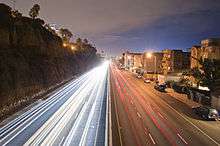
The Santa Monica Freeway (Interstate 10) begins in Santa Monica near the Pacific Ocean and heads east. The Santa Monica Freeway between Santa Monica and downtown Los Angeles has the distinction of being one of the busiest highways in all of North America. After traversing the Greater Los Angeles area, I-10 crosses seven more states, terminating at Jacksonville, Florida. In Santa Monica, there is a road sign designating this route as the Christopher Columbus Transcontinental Highway. State Route 2 (Santa Monica Boulevard) begins in Santa Monica, barely grazing State Route 1 at Lincoln Boulevard, and continues northeast across Los Angeles County, through the Angeles National Forest, crossing the San Gabriel Mountains as the Angeles Crest Highway, ending in Wrightwood. Santa Monica is also the western terminus of Historic U.S. Route 66. Close to the eastern boundary of Santa Monica, Sepulveda Boulevard reaches from Long Beach at the south, to the northern end of the San Fernando Valley. Just east of Santa Monica is Interstate 405, the San Diego Freeway, a major north–south route in Los Angeles and Orange counties.
The City of Santa Monica has purchased the first ZeroTruck all-electric medium-duty truck. The vehicle will be equipped with a Scelzi utility body, it is based on the Isuzu N series chassis, a UQM PowerPhase 100 advanced electric motor and is the only US built electric truck offered for sale in the United States in 2009.[78]
Bus
The city of Santa Monica runs its own bus service, the Big Blue Bus, which also serves much of West Los Angeles and the University of California, Los Angeles (UCLA). A Big Blue Bus was featured prominently in the action movie Speed.
The city of Santa Monica is also served by the Los Angeles County Metropolitan Transportation Authority's (Metro) bus lines. Metro also complements Big Blue service, as when Big Blue routes are not operational overnight, Metro buses make many Big Blue Bus stops, in addition to MTA stops.
Light rail
Design and construction on the 6.6-mile extension (10.6 km) of the Expo Line from Culver City to Santa Monica started in September 2011, with service beginning on May 20, 2016. Santa Monica Metro stations include 26th Street/Bergamot, 17th Street/Santa Monica College, and Downtown Santa Monica. Travel time between the downtown Santa Monica and the downtown Los Angeles termini is approximately 47 minutes.
Historical aspects of the Expo line route are noteworthy. It uses the former Los Angeles region's electric interurban Pacific Electric Railway's right-of-way that ran from the Exposition Park area of Los Angeles to Santa Monica. This route was called the Santa Monica Air Line and provided electric-powered freight and passenger service between Los Angeles and Santa Monica beginning in the 1920s.[79] Passenger service was discontinued in 1953, but diesel-powered freight deliveries to warehouses along the route continued until March 11, 1988.[80] The abandonment of the line spurred future transportation considerations and concerns within the community, and the entire right-of-way was purchased from Southern Pacific by Los Angeles Metropolitan Transportation Authority. The line was built in 1875 as the steam-powered Los Angeles and Independence Railroad to bring mining ore to ships in Santa Monica harbor and as a passenger excursion train to the beach.
Subway
Since the mid-1980s, various proposals have been made to extend the Purple Line subway to Santa Monica under Wilshire Boulevard. There are no current plans to complete the "subway to the sea," an estimated $5 billion project.
Airport and ports
The city owns and operates a general aviation airport, Santa Monica Airport, which has been the site of several important aviation achievements. Commercial flights are available for residents at LAX, a few miles south of Santa Monica.

Like other cities in Los Angeles County, Santa Monica is dependent upon the Port of Long Beach and the Port of Los Angeles for international ship cargo. In the 1890s, Santa Monica was once in competition with Wilmington, California, and San Pedro for recognition as the "Port of Los Angeles" (see History of Santa Monica, California).
City services
Emergency services
Two major hospitals are within the Santa Monica city limits, UCLA Santa Monica Hospital and St. John's Hospital. There are four fire stations providing medical and fire response within the city staffed with 6 Paramedic Engines, 1 Truck company, 1 Hazardous Materials team and 1 Urban Search & Rescue team. Santa Monica Fire Department has its own Dispatch Center. Ambulance transportation is provided by McCormick Ambulance Services.[81]
Law enforcement services is provided by the Santa Monica Police Department
The Los Angeles County Department of Health Services operates the Simms/Mann Health and Wellness Center in Santa Monica.[82] The Department's West Area Health Office is in the Simms/Mann Center.[83]
Internet services
Santa Monica has a municipal wireless network which provides several free city Wi-Fi hotspots[84] distributed around the City.
Government
Santa Monica is governed by the Santa Monica City Council, a Council-Manager governing body with seven members elected at-large. The mayor is Kevin McKeown, and the Mayor Pro Tempore is Terry O'Day. The other five current council members are Sue Himmelrich, Ted Winterer, Ana Maria Jara, Gleam Davis, and Greg Morena.[5]
Representation
In the California State Legislature, Santa Monica is in the 26th Senate District, represented by Democrat Ben Allen, and in the 50th Assembly District, represented by Democrat Richard Bloom.[85]
In the United States House of Representatives, Santa Monica is in California's 33rd congressional district, represented by Democrat Ted Lieu.[86]
Politics
In recent years, Santa Monica has voted Democratic in presidential elections, with the Democrats winning over 70% of the vote in all five presidential elections since 2000. The Republican party by contrast, failed to reach 25% of the vote in any of those elections, with both John McCain in 2008, and Donald Trump in 2016 failing to reach 20% of the vote. The Libertarian Party has increased its share of the vote in each of the last four presidential elections. Earning over 2% in the 2012 and 2016 elections, after failing to reach one percent in any of the three prior elections.
| Year | Democratic | Republican | Libertarian | Independents |
|---|---|---|---|---|
| 2016[87] | 80.03% 40,109 | 14.27% 7,153 | 2.75% 1,376 | 2.81% 1,409 |
| 2012[88] | 75.68% 36,000 | 20.55% 9,776 | 2.05% 976 | 1.72% 816 |
| 2008[89] | 79.30% 39,918 | 18.79% 9,461 | 0.57% 289 | 1.33% 670 |
| 2004[90] | 75.06% 36,676 | 23.68% 11,569 | 0.50% 243 | 0.77% 374 |
| 2000[91] | 71.67% 23,996 | 21.25% 7,114 | 0.49% 165 | 0.66% 2,205 |
Economy
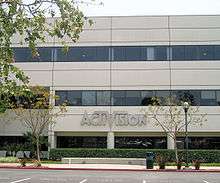

Santa Monica is home to the headquarters of many notable businesses, such as Beachbody, Fatburger,[92] Hulu, Illumination Entertainment, Lionsgate Films,[93] Macerich, Miramax, the RAND Corporation, Saban Capital Group, The Recording Academy (which presents the annual Grammy Awards), TOMS Shoes,[94] and Universal Music Group. Atlantic Aviation[95] is at the Santa Monica Airport. The National Public Radio member station KCRW is at the Santa Monica College campus. VCA Animal Hospitals is just outside the eastern city limit.[96]
A number of game development studios are based in Santa Monica, making it a major location for the industry. These include:
- Activision Blizzard (which includes Activision)
- Cloud Imperium Games (Creators of Star Citizen)[97]
- Naughty Dog (Creators of Crash Bandicoot (1996–1999), Jak & Daxter and Uncharted franchises)[98]
- PUBG Corporation (North American station, developed Miramar map in PUBG)[99]
- Riot Games, the creator of League of Legends, is just outside the eastern city limit.
- Treyarch
Recently, Santa Monica has emerged as the center of the Los Angeles region called Silicon Beach, and serves as the home of hundreds of venture capital funded startup companies.[100]
Former Santa Monica businesses include Douglas Aircraft (now merged with Boeing),[101] GeoCities (which in December 1996 was headquartered on the third floor of 1918 Main Street in Santa Monica[102]), Metro-Goldwyn-Mayer,[103] and MySpace (now headquartered in Beverly Hills).[104]
Top employers
According to the City's 2012–2013 Comprehensive Annual Financial Report,[105] the top employers in the city are:
| # | Employer | # of Employees |
|---|---|---|
| 1 | City of Santa Monica | 2,528 |
| 2 | Santa Monica – UCLA Medical Center | 2,079 |
| 3 | Santa Monica College | 1,953 |
| 4 | Saint John's Health Center | 1,676 |
| 5 | Santa Monica-Malibu Unified School District | 1,457 |
| 6 | RAND Corporation | 842 |
| 7 | Universal Music Group | 743 |
| 8 | Activision Blizzard and Activision | 692 |
| 9 | ET Whitehall (Shutters and Casa del Mar) | 568 |
| 10 | Lionsgate Entertainment | 555 |
Sport
The men's and women's marathon ran through parts of Santa Monica during the 1984 Summer Olympics.[106] The Santa Monica Track Club has many prominent track athletes, including many Olympic gold medalists. Santa Monica is the home to Southern California Aquatics,[107] which was founded by Olympic swimmer Clay Evans and Bonnie Adair. Santa Monica is also home to the Santa Monica Rugby Club, a semi-professional team that competes in the Pacific Rugby Premiership, the highest-level rugby union club competition in the United States.
During the 2028 Summer Olympics. Santa Monica will host beach volleyball and surfing.[108]
In popular culture
Film and television
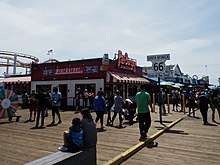
Hundreds of moving pictures have been shot or set in part within the city of Santa Monica.[109]
Films
One of the oldest exterior shots in Santa Monica is Buster Keaton's Spite Marriage (1929) which shows much of 2nd Street. The comedy It's a Mad, Mad, Mad, Mad World (1963) included several scenes shot in Santa Monica, including those along the California Incline, which led to the movie's treasure spot, "The Big W". The Sylvester Stallone film Rocky III (1982) shows Rocky Balboa and Apollo Creed training to fight Clubber Lang by running on the Santa Monica Beach, and Stallone's Demolition Man (1993) includes Santa Monica settings. In Pee-wee's Big Adventure (1985), the theft of Pee-wee's bike occurs on the Third Street Promenade.[110] Henry Jaglom's indie Someone to Love (1987), the last film in which Orson Welles appeared, takes place in Santa Monica's venerable Mayfair Theatre. Heathers (1989) used Santa Monica's John Adams Middle School for many exterior shots. The Truth About Cats & Dogs (1996) is set entirely in Santa Monica, particularly the Palisades Park area, and features a radio station that resembles KCRW at Santa Monica College. 17 Again (2009) was shot at Samohi. Other films that show significant exterior shots of Santa Monica include Fletch (1985), Species (1995), Get Shorty (1995), and Ocean's Eleven (2001). Richard Rossi's biopic Aimee Semple McPherson opens and closes at the beach in Santa Monica. Iron Man features the Santa Monica pier and surrounding communities as Tony Stark tests his experimental flight suit.
The documentary Dogtown and Z-Boys (2001) and the related dramatic film Lords of Dogtown (2005) are both about the influential skateboarding culture of Santa Monica's Ocean Park neighborhood in the 1970s.
The Santa Monica Pier is shown in many films, including They Shoot Horses, Don't They? (1969), The Sting (1973), Ruthless People (1986), Beverly Hills Cop III (1994), Clean Slate (1994), Forrest Gump (1994), The Net (1995), Love Stinks (1999), Cellular (2004), The Cutting Edge: Going for the Gold (2006), Iron Man (2008) and Hannah Montana: The Movie (2009).
The films The Doors (1991) and Speed (1994) featured vehicles from Santa Monica's Big Blue Bus line, relative to the eras depicted in the films.
The city of Santa Monica (and in particular the Santa Monica Airport) was featured in Roland Emmerich's disaster film 2012 (2009). A magnitude 10.9 earthquake destroys the airport and the surrounding area as a group of survivors escape in a personal plane. The Santa Monica Pier and the whole city sinks into the Pacific Ocean after the earthquake.
Television
A number of television series have been set in Santa Monica, including Baywatch, Goliath,[111] Pacific Blue, Private Practice, and Three's Company. The Santa Monica pier is shown in the main theme of CBS series NCIS: Los Angeles. In Buffy the Vampire Slayer, the main exterior set of the town of Sunnydale, including the infamous "sun sign", was in Santa Monica in a lot on Olympic Boulevard.[112][113]
Literature
The main character from Edgar Rice Burroughs' fantasy novel, The Land That Time Forgot (serialized in 1918 and published in book form in 1924) was a shipbuilder from Santa Monica.
Horace McCoy's 1935 novel They Shoot Horses, Don't They? is set at a dance marathon held in a ballroom on the Santa Monica Pier.
Raymond Chandler's most famous character, private detective Philip Marlowe, frequently has a portion of his adventures in a place called "Bay City", which is modeled on Depression-era Santa Monica.[114] In Marlowe's world, Bay City is "a wide-open town", where gambling and other crimes thrive due to a massively corrupt and ineffective police force.
In Gennifer Choldenko's historical fiction novel for young adults, Al Capone Does My Shirts (2006), the Flanagans move to Alcatraz from Santa Monica.
Tennessee Williams lived (while working at MGM Studios) in a hotel on Ocean Avenue in the 1940s. At that location he wrote the play The Glass Menagerie (that premiered in 1944). His short story, "The Mattress by the Tomato Patch" (1954), was set near Santa Monica Beach and mentions the clock visible in much of the city, high up on The Broadway Building, on Broadway near Second Street.
Music
- Notable locations
- Kim Kibum, a member of the popular Korean boy band Super Junior attended Santa Monica High School.
- The band Linkin Park is named in homage to Santa Monica's Lincoln Park (now called Christine Emerson Reed Park[115]).
- The National Academy of Recording Arts and Sciences is based in Santa Monica on Olympic Boulevard.
- Universal Music Group is based in Santa Monica. Several of its labels, such as A&M Records, Aftermath Entertainment (started by Dr. Dre), G-Unit Records (created by 50 Cent & Sha Money XL), Geffen Records, Interscope (started by Jimmy Iovine), and Shady Records, are based in Santa Monica, CA.
- Works
- The folk Australian duo, Angus and Julia Stone, released a single titled "Santa Monica Dream" in the album "Down the Way".
- The ska/reggae band, Bedouin Soundclash has a song entitled "Santa Monica".
- Sheryl Crow's song "All I Wanna Do" mentions Santa Monica Boulevard
- The band Everclear released a song titled "Santa Monica" in 1995, which became their first mainstream hit.
- The British singer-songwriter Noel Harrison released a song and album titled Santa Monica Pier (1968).[116]
- In 1948, bandleader Kay Kyser released a 78 record of the novelty song "When Veronica Plays the Harmonica (Down at the Pier in Santa Monica)".
- One of the few songs musical satirist Tom Lehrer has recorded since the 1970s is a tribute to the holidays of the Jewish calendar entitled "I'm Spending Hanukkah in Santa Monica".
- Santa Monica is referenced throughout Jack's Mannequin's debut album Everything In Transit.
- John Mayer's song "In Your Atmosphere" mentions Wilshire Boulevard.
- Richard Rossi released a song entitled "Santa Monica," celebrating the Santa Monica Pier, on his album Seasons of My Heart.
- The band Savage Garden released a song titled "Santa Monica" off their #3 US album Savage Garden (1997).
- The System Of A Down song "Lost in Hollywood" mentions the city.[117]
- The modern rock band Theory of a Deadman's song titled "Santa Monica", is a first-person account about a girl leaving her significant other to start a new life in Santa Monica.
- Santa Monica is referenced in the weezer single "Hash Pipe".[118]
Video games
Santa Monica is featured in the video games: Driver (1999), True Crime: Streets of LA (2003), Destroy All Humans! (2004), Grand Theft Auto San Andreas (2004) as a fictional district – Santa Maria Beach, Vampire: The Masquerade – Bloodlines (2004), L.A. Rush (2005), Tony Hawk's American Wasteland (2005), Midnight Club: Los Angeles (2008), Cars Race-O-Rama (2009) as a fictional city – Santa Carburera, Call of Duty: Ghosts (2013) as a fictional U.S. military base – Fort Santa Monica, Grand Theft Auto V (2013) as a fictional district – Del Perro, The Crew (2014), and Need for Speed (2015).
Notable people
- Amy Alcott (born 1956), golfer[119]
- Jack Black, actor and musician
- Carly Chaikin, actress
- Cody Decker (born 1987), Major League Baseball player[120]
- Pat Doyle (born 1944), baseball coach[121]
- Lynette "Squeaky" Fromme, former Charles Manson follower accused of attempted murder of U.S President Gerald Ford
- Max Fried (born 1994), Major League Baseball pitcher[122]
- Helen Golay, known for the Black Widow murders who she committed from 1999 to 2005
- Ashley Grossman (born 1993), water polo player[123]
- Brian Horwitz (born 1982), Major League Baseball player[124]
- Perry Klein (born 1971), American football quarterback in the National Football League; played for the Atlanta Falcons[125]
- Louise Lieberman (born 1977), soccer coach and former player[126]
- Jon Moscot (born 1991), Major League Baseball player[127]
- Sheree North, dancer and actress
- Robert Redford, actor, director, and environmentalist
- Christina Ricci, actress
- Randy Rhoads, guitarist
- Samantha Shapiro (born 1993), gymnast[128]
- Frank Spellman (1922–2017), Olympic champion weightlifter[129][130]
Sister cities



See also
- 2013 Santa Monica shooting
- Aragon Ballroom (Ocean Park, Santa Monica, California)
- List of cities and towns in California
- List of City of Santa Monica Designated Historic Landmarks
- List of people from Santa Monica, California
- Muscle Beach
- Santa Monica neighborhoods
- Arcadia Bandini de Stearns Baker, co-founder and benefactress of Santa Monica
- List of public art in Santa Monica, California
- Image of zoning map of Los Angeles outlining Santa Monica,1927. Los Angeles Times Photographic Archive (Collection 1429). UCLA Library Special Collections, Charles E. Young Research Library, University of California, Los Angeles.
References
- Archibald, Ashley (April 26, 2013). "Report: SaMo air quality some of the best in SoCal". Daily Press. Santa Monica, California. Retrieved January 5, 2015.
- Simpson, David Mark (June 3, 2015). "The mystery of Santa Monica's city motto". Santa Monica Daily Press.
- "California Cities by Incorporation Date". California Association of Local Agency Formation Commissions. Archived from the original (Microsoft Word) on February 21, 2013. Retrieved August 25, 2014.
- "Charter of the City of Santa Monica". Quality Code Publishing. Retrieved November 4, 2014.
- "Santa Monica City Council". City of Santa Monica. Retrieved December 21, 2019.
- "2019 U.S. Gazetteer Files". United States Census Bureau. Retrieved July 1, 2020.
- "Santa Monica". Geographic Names Information System. United States Geological Survey. Retrieved October 20, 2014.
- "Santa Monica (city) QuickFacts". United States Census Bureau. Retrieved March 15, 2015.
- "Population and Housing Unit Estimates". United States Census Bureau. May 24, 2020. Retrieved May 27, 2020.
- "U.S. Census website". United States Census Bureau. Retrieved January 31, 2008.
- "US Board on Geographic Names". United States Geological Survey. October 25, 2007. Retrieved January 31, 2008.
- Begley, Sarah (December 10, 2015). "The Most Popular Places to Check In on Facebook in 2015". Time. Retrieved January 27, 2016.
- Munro, Pamela, et al. Yaara' Shiraaw'ax 'Eyooshiraaw'a. Now You're Speaking Our Language: Gabrielino/Tongva/Fernandeño. Lulu.com: 2008.
- Paula A. Scott, Santa Monica: a history on the edge. Making of America series (Arcadia Publishing, 2004), 17–18.
- "Water and Power Associates". waterandpower.org.
- Fogelson, Robert M. (1993). The fragmented metropolis: Los Angeles, 1850–1930. Berkeley: University of California Press. p. 200. ISBN 978-0-520-08230-4.
- Mark McIntire, Minorities and Racism, Free Venice Beachhead #126, June 1980.
- Parker, Dana T. Building Victory: Aircraft Manufacturing in the Los Angeles Area in World War II, pp. 13–24, Cypress, CA, 2013. ISBN 978-0-9897906-0-4.
- Herman, Arthur. Freedom's Forge: How American Business Produced Victory in World War II, pp. 202–3, Random House, New York, NY, 2012. ISBN 978-1-4000-6964-4.
- Parker, Dana T. Building Victory: Aircraft Manufacturing in the Los Angeles Area in World War II, pp. 7–48., Cypress, CA, 2013. ISBN 978-0-9897906-0-4.
- Zinzi, Janna A. (August 1, 2020). "The Tragic History of L.A.'s Black Family Beach Havens". Daily Beast. Retrieved August 1, 2020.
- History of Beach Volleyball Retrieved August 1, 2020
- Ben Tracy (February 18, 2009). "Santa Monica's Disputed Steps". CBS News TV report. Archived from the original on February 21, 2009. Retrieved February 24, 2010.
- "Weatherbase: Historical Weather for Los Angeles, California, United States of America". Weatherbase.com. Retrieved August 13, 2009.
- "Interactive USDA Gardening and Plant Hardiness Zone Map for California". Plantmaps.com. Retrieved October 31, 2016.
- "Santa Barbara.com: June Gloom". SantaBarbara.com. Retrieved August 13, 2009.
- "NOAA Santa Monica Climate Normals". National Oceanic and Atmospheric Administration.
- "Sustainable Santa Monica". Retrieved May 24, 2016.
- "Big Blue Bus, Fueling a Renewable Future One Bus at a Time – Clean Energy Fuels". Clean Energy Fuels. July 16, 2015. Retrieved May 24, 2016.
- "Sustainability" (PDF). www.smgov.net.
- "Santa Monica Office of Sustainability and the Environment: Solar Santa Monica". Retrieved May 24, 2016.
- "Clean Power Alliance". Clean Power Alliance.
- "Santa Monica OSE - Clean Power Alliance FAQs". www.smgov.net.
- "Santa Monica Addresses Climate Crisis with Ambitious Carbon Emission Cuts and Adaptation Measures". santamonica.gov.
- "Santa Monica CA – Visitor Information, Hotels, Dining" (PDF). Santa Monica. Archived (PDF) from the original on March 8, 2012. Retrieved May 24, 2016.
- "Santa Monica OSE – Rules & Regulations". Retrieved May 24, 2016.
- "Taking the green out of green building certification". Santa Monica Daily Press. March 12, 2014. Retrieved May 24, 2016.
- "Zero Waste Strategic Operations Plan – City of Santa Monica". Retrieved May 24, 2016.
- "Action plan" (PDF). nelsonnygaard.com. 2014.
- "The greenest US cities". City Mayors. April 27, 2006. Retrieved June 13, 2012.
- "Environmental Programs Division (EPD) – City of Santa Monica". Smgov.net. Retrieved June 13, 2012.
- "Census of Population and Housing". Census.gov. Retrieved June 4, 2015.
- "Santa Monica, California". City-Data.com. Retrieved June 13, 2012.
- "2010 Census Interactive Population Search: CA – Santa Monica city". U.S. Census Bureau. Archived from the original on October 6, 2014. Retrieved July 12, 2014.
- "Santa Monica (city) QuickFacts". United States Census Bureau. Archived from the original on October 26, 2005. Retrieved September 27, 2014.
- https://statisticalatlas.com/place/California/Santa-Monica/Ancestry
- "CNN Money – 25 Most Educated Cities". Money.cnn.com. Archived from the original on May 11, 2012. Retrieved June 13, 2012.
- "U.S. Census website". United States Census Bureau. Retrieved June 13, 2012.
- "Santa Monica CA Crime Statistics (2006 Crime Data)". Retrieved August 25, 2009.
- "Crime Statistics for Santa Monica". Retrieved August 25, 2009.
- Schley, Reeve T. (September 25, 2002). "Santa Monica Crime Rate Is Highest in Los Angeles County". Santa Monica Mirror. Archived from the original on October 3, 2002. Retrieved August 25, 2009.
- "Sustainable City Progress Report". Archived from the original on July 24, 2011. Retrieved August 25, 2009.
- "Measure Y: Lowest Enforcement Priority for Adult, Personal Use of Marijuana City of Santa Monica". Retrieved August 25, 2009.
- Emma Trotter (July 31, 2009). "Two years of toking it up". Santa Monica Daily Press. Archived from the original on July 29, 2012. Retrieved August 25, 2009.
- "Police Chief Calls for Regional Approach to Gang Violence". Surfsantamonica.com. Retrieved June 13, 2012.
- Don Terry (October 20, 1998). "Death of gangster Omar Sevilla". New York Times. Retrieved June 13, 2012.
- "NBC Los Angeles report on the capture of Fietze's killer". Nbclosangeles.com. Retrieved June 13, 2012.
- "Gang Bullets Pierce Santa Monica's Image". Los Angeles Times. October 29, 1998. Retrieved June 13, 2012.
- "Violence in Pico". Surfsantamonica.com. Retrieved June 13, 2012.
- "Police Chief to Address Public Safety Concerns". Los Angeles Times. October 21, 1998. Retrieved September 22, 2011.
- "Suspects Charged in Westside Clothing Store Shooting". Archived from the original on September 5, 2009.
- "'Gangster's Paradise Lost'". Streetgangs.com. October 27, 1998. Archived from the original on January 11, 2013. Retrieved June 13, 2012.
- Santa Monica Alternative School House Curriculum, SMASH Vision Statement". Retrieved May 11, 2011.
- http://www.smmusd.org/ SMMUSD. Retrieved May 11, 2011.
- "LCA Saints – The Lighthouse Christian Academy in Santa Monica CA". The Lighthouse Christian Academy in Santa Monica CA.
- "Saint Anne School". Saint Anne School. Retrieved June 13, 2012.
- "サンタモニカ校・高等部." Asahi Gakuen. Retrieved on March 30, 2014. "DANIEL WEBSTER MIDDLE SCHOOL 11330 W. Graham Place, Los Angeles, CA 90064 "
- "Mapping LA: Sawtelle." Los Angeles Times. Retrieved on May 9, 2014.
- Puig, Claudia. "'School of the Rising Sun' : Surroundings Are American but Classes, Traditions Are Strictly Japanese." Los Angeles Times. November 13, 1986. p. 1. Retrieved on March 30, 2014.
- "Santa Monica Bike Action Plan". City of Santa Monica.
- "Bikeshare is coming to Santa Monica!". City of Santa Monica.
- "Santa Monica". The League of American Bicyclists. May 24, 2013.
- "Los Angeles County Bicycle Coalition". Los Angeles County Bicycle Coalition.
- Hymon, Steve (May 17, 2017). "Are the pedals of change in Los Angeles County gaining momentum?". The Source. Retrieved October 14, 2017.
- "OTS Collision Rankings". California Office of Traffic Safety.
- "Critical Mass bike ride may be at braking point". Los Angeles Times. December 7, 2007. Retrieved March 7, 2015.
- Clark, Kate (August 30, 2018). "Santa Monica will allow Lime, Bird, Lyft and JUMP to operate e-scooters". TechCrunch. Oath Inc. Retrieved August 30, 2018.
- "Santa Monica Introduces Electric Zero Truck Into City Fleet: #evworld". Evworld.com. June 21, 2009. Retrieved June 13, 2012.
- "Santa Monica Air Line". Electric Railway Historical Association of Southern California.
- Morgenthaler, Anne (March 14, 1988). "END OF THE LINE—The last train out of SM blows a final whistle". Santa Monica Outlook.
- "Ambulance Transportation". Santa Monica Fire Department. Santa Monica Fire Department. Retrieved June 13, 2012.
- "Simms/Mann Health and Wellness Center." Los Angeles County Department of Health Services. Retrieved on March 17, 2010. Archived December 14, 2010, at the Wayback Machine
- "SPA5 – West Area Health Office." Los Angeles County Department of Health Services. Retrieved on March 18, 2010. Archived March 27, 2012, at the Wayback Machine
- "Archived copy" (PDF). Archived from the original (PDF) on October 23, 2016. Retrieved December 3, 2018.CS1 maint: archived copy as title (link)
- "Statewide Database". UC Regents. Archived from the original on February 1, 2015. Retrieved November 21, 2014.
- "California's 33rd Congressional District - Representatives & District Map". Civic Impulse, LLC. Retrieved September 29, 2014.
- "Supplement to the Statement of Vote - Political Districts within Counties for President" (PDF).
- "Supplement to the Statement of Vote - Political Districts within Counties for President" (PDF).
- "Supplement to the Statement of Vote - Political Districts within Counties for President" (PDF).
- "Supplement to the Statement of Vote - Political Districts within Counties for President" (PDF).
- "Supplement to the Statement of Vote - Political Districts within Counties for President" (PDF).
- "Contact Archived February 2, 2010, at the Wayback Machine." Fatburger. Retrieved on March 5, 2010.
- "INVESTOR RELATIONS CONTACT." Lions Gate Films. Retrieved on February 9, 2016.
- "Legal Information & Privacy Policy Archived January 26, 2012, at the Wayback Machine." TOMS Shoes. Retrieved on July 30, 2010.
- Ericksen, Olin. "Airport Commission Gives New Operator Thumbs Up, Despite Fears Jet Traffic Will Rise". The Lookout. Retrieved June 13, 2012.
- "Contact VCA". Retrieved February 6, 2019.
- Makuch, Eddie (April 23, 2013). "Star Citizen dev opens new office". GameSpot. CBS Interactive. Archived from the original on November 3, 2014. Retrieved November 22, 2014.
- "Time Line". Archived from the original on June 4, 2004. Retrieved April 15, 2017.. Naughty Dog. June 4, 2004. Retrieved on May 5, 2010.
- "Company Profile for PUBG Corporation". Business Wire. Retrieved February 6, 2019.
- Ungerleider, Neal (October 31, 2014). "Why A Subway-Building Binge Could Transform L.A.'s Tech Culture". Fast Company. Retrieved December 28, 2015.
- "Airport History – SMO: Santa Monica Municipal Airport". smgov.net. Retrieved January 25, 2017.
- "Advertising and Sponsorship Information". Archived from the original on December 19, 1996.CS1 maint: BOT: original-url status unknown (link). GeoCities. December 19, 1996. Retrieved on April 30, 2009.
- "Corporate Information". Archived from the original on October 6, 2000.CS1 maint: BOT: original-url status unknown (link). Metro-Goldwyn-Mayer. October 6, 2000. Retrieved on February 6, 2012. "Corporate Headquarters Metro-Goldwyn-Mayer Inc. 2500 Broadway Street Santa Monica, CA 90404-3061"
- "MySpace company and contact information". ComputerHope.
- "City of Santa Monica CAFR" (PDF). 1.smgov.net. Retrieved July 19, 2014.
- 1984 Summer Olympics official report. Archived November 2, 2010, at the Wayback Machine Volume 1. Part 1. pp. 97–98.
- "SCAQ". www.swim.net.
- "Assets" (PDF). la24-prod.s3.amazonaws.com.
- "Most Popular Titles With Location Matching "Santa Monica, California, USA"". IMDb. Retrieved May 24, 2016.
- Martino, Alison (August 28, 2014). "Third Street Promenade Before the Gap Even Existed". CityThink. Los Angeles Magazine. Retrieved February 6, 2019.
- Huver, Scott Huver (October 14, 2016). "David E. Kelley Has a Romantic Reason for Setting 'Goliath' in Santa Monica". Moviefone.
- Various authors (updated 2007). The Ultimate Buffy and Angel Trivia Guide Sets and Locations https://www.imdb.com/title/tt0118276/locations Sets and Locations Check
|url=value (help). Missing or empty|title=(help)CS1 maint: uses authors parameter (link) - Various authors (updated 2006). "Filming Locations for Buffy the Vampire Slayer". IMDb.
- Hiney, Tom (1999). Raymond Chandler. Grove Press. p. 92. ISBN 978-0-8021-3637-4.
- "Dedication Ceremony for Park to Be Held Sunday". Los Angeles Times. June 13, 1998. Retrieved February 6, 2019.
- Steve Harvey, "Only in L.A.", Los Angeles Times, February 9, 1990.
- "System Of A Down – Lost In Hollywood Lyrics". Metrolyrics.com. Retrieved June 13, 2012.
- "Weezer – Hash Pipe Lyrics | MetroLyrics". www.metrolyrics.com. Retrieved October 10, 2018.
- "Biography". July 22, 2013.
- "Cody Decker - Baseball". UCLA.
- "ABCA Hall of Fame". ABCA Hall of Fame.
- "Max Fried's Birthright From Israel to SunTrust Park". Atlanta Jewish Times. August 25, 2017.
- "Brian Horwitz Stats, Fantasy & News". MLB.com.
- "Perry Klein Stats". Pro-Football-Reference.com.
- "2001 Washington Freedom Roster on StatsCrew.com". www.statscrew.com.
- "Jon Moscot". ESPN.com.
- "Samantha Shapiro - Women's Gymnastics". Stanford University Athletics.
- Seip, Jim. "Olympic fire still burns for 93-year-old Floridian Frank Spellman, weighlifting medalist". Naples News.
- "Sister Cities". Santa Monica Sister City Association.
External links
| Wikimedia Commons has media related to Santa Monica, California. |
| Wikisource has the text of the 1921 Collier's Encyclopedia article Santa Monica. |
- City of Santa Monica
- Santa Monica Chamber of Commerce
- Santa Monica Little League
- Santa Monica Public Library

- Santa Monica, California at Curlie
- A Weekend in Santa Monica – slideshow by The New York Times
- City of Santa Monica at the Wayback Machine (archived February 18, 1999)

